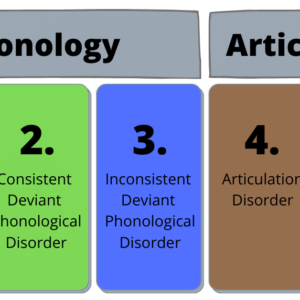Phonological Processes in Spanish-English Bilingual Children
$15.00

Course Type: Video – 1 hour
ASHA Course Code: Diversity, Equity, and Inclusion in Education, Training, Service Delivery, Public Policy – 7030
The phonological processes in Spanish-English bilingual development vary from monolingual development.
Due to the differences in speech development, bilingual children are often misdiagnosed as having a speech impairment. In this course, participants learned how to identify if phonological processes are due to age, second-language influence, or a true disorder. This enables participants to reduce both over- and under-identification of bilingual clients with speech impairments.
| Population | Early Childhood, School Age |
|---|---|
| Topics | Articulation/Phonology, Diversity, Equity, & Inclusion (DEI) |
| Duration | 1 hour |
| Credit | .1 Continuing Education Unit |
| Format | Video |
Financial Disclosure: Ellen Kester, Ph.D., CCC-SLP. Dr. Ellen Kester is the owner of Bilinguistics and receives a salary. Bilinguistics receives royalty payments for online courses.
Non-Financial Disclosure: Ellen Kester does not have any non-financial relationships to disclose.
Financial Disclosure: Brenda Gorman, Ph.D., CCC-SLP. Dr. Brenda Gorman does not have any financial relationships to disclose.
Non-Financial Disclosure: Dr. Gorman does not have any non-financial relationships to disclose.
There is limited information on the acquisition of phonological processes in Spanish-English bilingual children. For English-speaking children, several researchers (Bowen, 1998; Grunwell, 1997) have listed the ages at which most phonological processes are eliminated (e.g., final consonant deletion – eliminated by approximately 3 years, 3 months; fronting – eliminated by approximately 3 years, 6 months; cluster reduction – eliminated by approximately 4 years). Goldstein and Iglesias (1996a, 1996b) provided research detailing the frequencies of occurrence of phonological processes for both typically-developing and impaired Spanish-speaking 3- and 4- year old children, and also identified those processes which are less commonly observed in both groups. The awareness of the less common patterns assists us with differential diagnosis, as typically-developing children would not usually exhibit such processes as backing, metathesis, deaffrication, or nasalization.
Knowledge about the ages at which the frequency of processes diminishes for typically-developing bilingual children will allow the clinician to more confidently diagnose delayed or disordered speech patterns. Due to the differences in speech development and sound structures of the languages between Spanish and English, norms for English-speaking children should not be used. Bilingual children are often misdiagnosed as having a speech impairment when, in fact, they are exhibiting normal processes of speech acquisition for a child acquiring two languages. When children are learning two languages, the languages influence one another. The most common pattern we see is called forward transfer, in which elements from a child’s native language (L1) are used in their second language (l2). Forward transfer can be positive or negative. Positive transfer occurs when the element being transferred from LI to L2 is the same in both languages, while negative transfer occurs when the element being transferred from L1 to L2 is different across the two languages. For a native Spanish speaker learning English, an example of positive transfer can be seen in the production of /n/ in the final position of a word. The phoneme /n/ can occur in the word final position in both Spanish (L1) and English (L2), so we would expect positive transfer of this production from Spanish to English. Conversely, an example of negative transfer would be the production of /k/ in the word final position. This phoneme does not occur in word final position in Spanish but it is allowed in English. In this case forward transfer will likely be negative, and the final /k/ will be omitted or produced in error.
The data from the current study were collected in the norming process of the Bilingual Articulation and Phonology Assessment (BAPA). In the current study we evaluate speech skills, specifically the use of phonological processes, in Spanish-English bilingual children ages 3-10 years. Processes analyzed include: initial, medial, and final consonant deletion; fronting; backing; stopping; weak syllable deletion; voicing; devoicing; gliding; cluster reduction; consonant sequence reduction; tap/trill deviation; denasalization; affrication; deaffrication; and assimilation. We will present information about the use of phonological processes in bilingual children in their production of both English and Spanish. We will describe the similarities and differences between their use of phonological processes in the two languages as well as how overlapping processes can affect the assessment and treatment process.
A thorough understanding of the speech development process in bilingual children in the United States will support clinicians in the appropriate diagnosis of speech impairments. The most recent ASHA Schools Survey (2012) indicated that approximately 75% of all speech-language pathologists reported that they do not feel confident in making diagnostic decisions about children from different language backgrounds. Providing normative information about the development (or suppression) of phonological processes in bilingual children will help speech-language pathologists more confidently decide whether error patterns are typical for bilingual development or whether they are indicative of speech impairment. Identifying the students who really need support will enhance educational outcomes and save valuable special education resources.
In addition to using normative data about bilingual speech development for appropriate diagnostic decisions, this information is also invaluable in identifying appropriate intervention targets. By knowing the ages at which children are expected to no longer exhibit processes, clinicians can prioritize the processes targeted first and continue along an expected sequence of development. Normative data can also allow the clinician to compare the child’s performance to normative data to measure progress over time.
Participants will:
Distinguish between speech differences that are due to age, second-language influence, or a true disorder
List four phonological patterns that lead to misdiagnosis
Identify several alternative forms of assessment
Modify evaluation procedures to include informal testing and analysis of results
Time-Ordered Agenda:
05 minutes: Introduction
10 minutes: Background about the need for information on phonological development in bilingual children.
10 minutes: Review of the research on phonological development in bilinguals
10 minutes: The goals, participants, and procedures of the current study
10 minutes: Results and their significance
10 minutes: Clinical implications
05 minutes: Summary
References
American Speech-Language-Hearing Association. (2012). 2012 Schools survey. Survey summary report: Number and type of responses, SLPs. Available from www.asha.org.
Bowen, C. (1998). Developmental phonological disorders. A practical guide for families and teachers. Melbourne: ACER Press.
Goldstein, B. & Iglesias, A. (1996a). Phonological patterns in normally developing Spanish-speaking 3- and 4-year-olds of Puerto Rican descent. Language, Speech, and Hearing Services in the Schools, 27, 82-90.
Goldstein, B. & Iglesias, A. (1996b). Phonological patterns in Puerto Rican Spanish-speaking children with phonological disorders. Journal of Communication Disorders, 29, 367-387.
Grunwell, P. (1997). Natural phonology. In M. Ball & R. Kent (Eds.), The new phonologies: Developments in clinical linguistics. San Diego, CA: Singular Publishing Group, Inc.
Need CEUs?

 Share
Share
 Tweet
Tweet
 LinkedIn
LinkedIn
 Pin
Pin
 Email
Email





